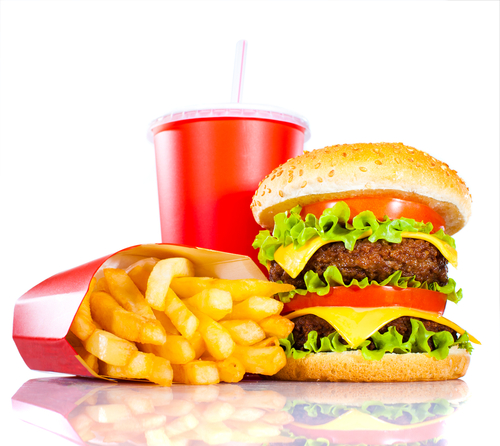Your body changes the chemical energy contained within the food you eat into the energy you need to stay alive.
Different foods contain different amounts of energy. Kilojoules (or joules) are a unit of energy. Sometimes energy in food is referred to as kilocalories or calories.
For example, a typical meal of a hamburger, chips and a fizzy drink contains about 4,000 kJ of energy.

The hamburger contains approximately 2,000 kJ, the chips contain 1,300 kJ and the fizzy drink contains about 700 kJ of energy.
This may seem like a lot of energy, but different people have different energy needs depending on their age and lifestyle. Shown below are the approximate energy needs of a wide range of people.
.jpg)
| Person | Energy need per day (kJ) |
|---|---|
| 2 year old | 4,000 |
| 10 year old | 8,000 |
| 14-year-old girl | 10,000 |
| 14-year-old boy | 12,000 |
| Adult female | 10,000 |
| Adult male | 11,000 |
| Adult male with an active job | 14,000 |
You may have heard people talking about how many calories there are in different foods. A calorie is not the same as a kJ - in fact 1 calorie is 4.184 kJ.
10,000 kJ is equal to about 2,390 calories.
Energy needs depend on age and lifestyle. An active person requires more energy than a person who works at a computer most of the day. A teenage boy will typically need more energy than a teenage girl of the same age, often because teenage boys are likely to be physically bigger than teenage girls - this isn't always the case though and depends on the lifestyle they lead.
It's important to provide your body with the correct amount of energy.
If a person takes in a lot of energy but does not lead an active lifestyle then they may become overweight, but a person who doesn't take in enough energy may become underweight, both of which can cause health issues.
It's also important to have a balanced diet, containing the correct amounts of vitamins, minerals and water. These are needed so your body can grow and do a lot of important jobs properly - for example, iron is a mineral and it transports oxygen in the blood. Vitamins like vitamin C help us to fight off illness and many of the reactions in our body happen in water. Water needs to be replaced because we lose some when we sweat, breathe out and when we go to the toilet!
In this activity, we will calculate the different energy requirements in a healthy daily diet.
Let's get started.







